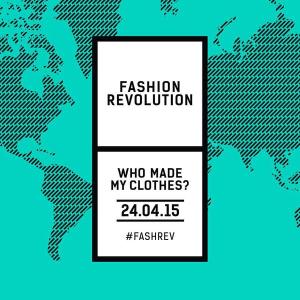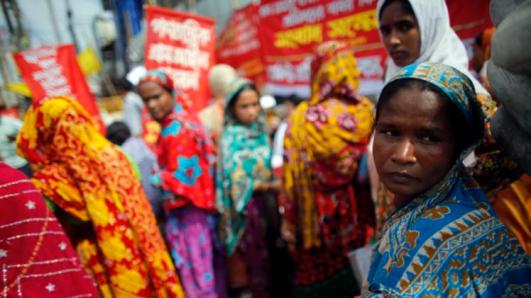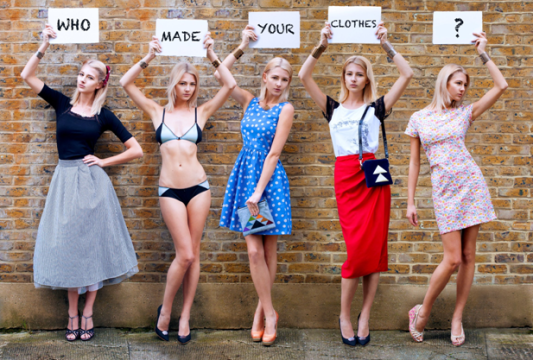Beyond Fashion Revolution Day
The Collapse
Today marks the two-year anniversary of the Rana Plaza factory collapse, a tragedy that needlessly took the lives of more than 1,100 garment workers in Bangladesh and injured an additional 2,500. This was the deadliest garment-industry accident to date, yet it was not an isolated event. Hundreds of garment workers around the world have lost their lives in factory fires and workplace accidents in the past several years. These incidents received minimal media attention, and little was done by the fashion industry in response. However, the human loss associated with Rana Plaza was too significant to overlook, and it received the global media attention that it deserved. Rana Plaza revealed systemic issues in the fast-fashion business model that pose significant challenges for garment workers in developing countries. It was emblematic of an industry dependent on cheap labor and lack of transparency and clearly demonstrated to the world that the true cost of fast-fashion is much, much higher than the $7 t-shirt from Target might lead you to believe.
The Response
Consumers, civil society, governments, and others responded with outrage, demanding that victims be compensated and fashion companies be held accountable for the tragedy. They expressed anger and disappointment regarding the lack of transparency, shocked that major fashion companies would be involved in such a horrific event. In the months following the collapse, a number of multi-stakeholder initiatives were launched in an effort to hold brands accountable, compensate victims, and begin making the necessary changes to ensure safer working conditions in Bangladesh’s garment industry.
- The Accord on Fire and Building Safety in Bangladesh (The Accord) is an agreement between fashion brands and trade unions designed to create a safer, healthier garment industry in Bangladesh. The Accord established an independent factory inspection program, and all brands are required to disclose their factories. Nearly 200 apparel brands have signed the legally binding agreement.
- The Alliance for Bangladesh Worker Safety (the Alliance) is an alternative corporate initiative founded by a group of North American garment retailers. This group of 26 aims to improve worker safety in Bangladesh through factory assessments, training, and a worker helpline. The major difference between the Alliance and the Accord is that the Alliance is not legally binding, which means the companies hold themselves responsible.
- Following the collapse, the International Labor Organization and the International Finance Corporation launched a joint initiative, the Better Work Program, in Bangladesh. Better Work is a partnership between government, suppliers, workers, and other relevant stakeholders. It’s goal is to improve compliance with global and national labor standards and laws by advising factories, promoting dialogue between workers and management, and working with the government to encourage sector changes.
- The Rana Plaza Donors Trust Fund was established to as a mechanism to collect corporate donations and distribute them to Rana Plaza victims and their families. Approximately $24 million has been raised to date, and the list of donors can be seen here.
The Current Situation
It’s been two years. A lot has changed, but a lot hasn’t. The response to Rana Plaza has been both encouraging and disappointing.
Thousands of factories have been inspected by the Accord and Alliance, with hundreds of factories taking remedial action. 150 new labor unions have been registered with the government, under the Better Work Program, and millions of dollars have been received for and distributed to victims and their families. Fashion brands have taken steps to be more transparent, and ethical fashion has been getting a lot more attention.
However, there are still many, many factories to be inspected and repaired. For the factories that are forced to close, garment workers will be out of jobs. More than half of the Rana Plaza survivors are still without jobs. Furthermore, while steps are being made to improve working conditions, there is evidence that things are not improving. Sam Maher of Labour Behind the Label shares, “ In terms of safety, things have improved. But the situation for trade unions is getting worse and conditions in the factories are not getting better.”
There is a $6 million shortfall in the $30 million Donors Trust Fund goal. Activist groups are calling specifically on brands like Benetton, Carrefour, JC Penney, Mango, The Children’s Place, and Walmart to increase their compensation. The fact that multi-million and billion dollar companies are unwilling to provide ample compensation speaks volumes of their lack of concern. Some Rana Plaza workers have still not received any financial compensation.
The Future
There’s obviously a long way to go, because nothing changes overnight. The progress that has been made is a good first step to making Bangladesh a safer place to work and the garment industry more transparent and ethical. But we can’t stop here.
It’s great that people are getting excited about #FashRev and making a social statement by wearing their clothes inside out and asking fashion companies #whomademyclothes?. It’s important to keep the issue on everyone’s mind, and that’s what social media is doing well. But it can’t stop there. Hashtags aren’t going to transform the industry. If the reason Rana Plaza happened in the first place was because various actors (fashion brands, suppliers, Bangladeshi government) took different actions to cut costs so they can provide clothes at the cheap price consumers are demanding, we have to stop demanding it! If we truly want to see a change, we need to put our money where our mouth is. Petitions, emails, and instagram photos of clothing tags won’t have as much of an impact as consumers shifting their dollars to ethical companies. We have the power to vote with our wallets.
Being an ethical consumer shouldn’t be a trend, and it shouldn’t just be something that’s done once a year as a token gesture of solidarity. As cliché as it sounds, it really is a lifestyle. And this fight isn’t just about garment workers in Bangladesh, but about labor exploitation in every industry and in every country. I’ll end with this quote from Sam Maher, Labour Behind the Label’s Director of Policy for Workers’ Safety:
“We need to recognise that change isn’t just about one sector in one country. If we want to see real change, we need to start demanding it – not just in Bangladesh but at home, by organising and fighting for a different vision of society where all the citizens of every country have the right to live in dignity.”
I hope we are all inspired to do that!
Here are some other Fashion Revolution blogs you should check out!
Fashion Revolution Day by Dom Fu
Fashion Revolution Day 2015 by Rebecca Burnett
Join Fashion Revolution & Demand That the Fashion Industry Clean Up Its Act by Nicola Stear
The Path Ahead by Christy Nicholson
We Are Fashion Revolution by Johanne Strenstrup
#whomademyclothes? Zady Knows by Leah Wise



Pingback: WE ARE FASHION REVOLUTION | BedreMode.nu